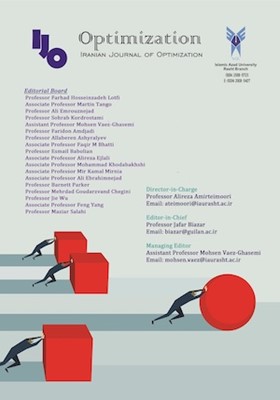Merger analysis using inverse DEA: the case of variable returns to scale
Subject Areas : Data Envelopment Analysis
1 - Faculty of Industrial Engineering and Management Science, Shahrood University of Technology
Keywords: Inverse DEA, Merger Analysis, Semi-additive technology, financial institute,
Abstract :
In a dynamic economy, mergers and consolidations of economic and finance sectors likebanks, etc. becoming more common. One of the applications of the inverseDEA is the merger analysis of a series of production units. Data envelopment analysis (DEA) measures the efficiency score of a decision making unit (DMU) considering its input and output level. On the other side, the inverse DEA approach aims to find required input levels for DMU to produce a presumed output level preserving the efficiency score. In a rather recent paper, (Gattoufi, Amin, & Emrouznejad, 2014) introduced an interesting application of inverse DEA models for merger analysis. The current paper extends this work by developing a generalized inverse DEA model assuming variable returns to scale. In contrast with (Gattoufi et al., 2014), it is shown that proposed models are always feasible and bounded. The idea is illustrated using a methodical argument and two numerical examples. An empirical study of financial institutes shows the strength and the applicability of the proposed methods.
REFERENCES
Amin, G. R., & Al-Muharrami, S. (2016). A new inverse data envelopment analysis model for mergers with negative data. IMA Journal of Management Mathematics.
Amin, G. R., Al-Muharrami, S., & Toloo, M. J. E. S. w. A. (2019). A combined goal programming and inverse DEA method for target setting in mergers. 115, 412-417.
Amin, G. R., & Boamah, M. I. (2020). A new inverse DEA cost efficiency model for estimating potential merger gains: a case of Canadian banks. Annals of Operations Research, 1-16.
Amin, G. R., & Boamah, M. I. J. A. o. O. R. A new inverse DEA cost efficiency model for estimating potential merger gains: a case of Canadian banks. 1-16.
Amin, G. R., Emrouznejad, A., & Gattoufi, S. (2017). Minor and major consolidations in inverse DEA: Definition and determination. Computers and Industrial Engineering, 103, 193-200.
Banker, R. D., Charnes, A., & Cooper, W. W. (1984). Some models for estimating technical and scale inefficiencies in data envelopment analysis. Management science, 30(9), 1078-1092.
Charnes, A., Cooper, W., & Rhodes, E. (1978). Measuring the efficiency of decision making units. European Journal of Operational Research, 2(6), 429-444.
Eyni, M., Tohidi, G., & Mehrabeian, S. J. J. o. t. O. R. S. (2017). Applying inverse DEA and cone constraint to sensitivity analysis of DMUs with undesirable inputs and outputs. 68(1), 34-40.
Gattoufi, S., Amin, G. R., & Emrouznejad, A. (2014). A new inverse DEA method for merging banks. Journal of Management Mathematics, 25(1), 73-87.
Ghiyasi, M. (2015). On inverse DEA model: The case of variable returns to scale. Computers & Industrial Engineering, 87, 407-409.
Ghiyasi, M. (2016). A DEA production technology and its usage for incorporation of collaboration in efficiency analysis: an axiomatic approach. International Transactions in Operational Research, 26, 1118-1134.
Ghiyasi, M. (2017). Inverse DEA based on cost and revenue efficiency. Computers and Industrial Engineering, 114, 258-263.
Ghiyasi, M., & Zhu, N. (2020). An inverse semi-oriented radial data envelopment analysis measure for dealing with negative data. IMA Journal of Management Mathematics.
Hadi-Vencheh, A., Foroughi, A. A. J. M., & Modelling, C. (2006). A generalized DEA model for inputs/outputs estimation. 43(5-6), 447-457.
Jahanshahloo, G. R., Soleimani-Damaneh, M., & Ghobadi, S. J. E. J. o. O. R. (2015). Inverse DEA under inter-temporal dependence using multiple-objective programming. 240(2), 447-456.
Jahanshahloo, G. R., Vencheh, A. H., Foroughi, A. A., & Matin, R. K. (2004). Inputs/outputs estimation in DEA when some factors are undesirable. Applied Mathematics Computation, 156(1), 19-32.
Lertworasirikul, S., Charnsethikul, P., & Fang, S.-C. (2011). Inverse data envelopment analysis model to preserve relative efficiency values: The case of variable returns to scale. Computers & Industrial Engineering, 61(4), 1017-1023.
Moradi-Motlagh, A., & Babacan, A. (2015). The impact of the global financial crisis on the efficiency of Australian banks. Economic Modelling, 46, 397-406.
Paradi, J. C., & Zhu, H. (2013). A survey on bank branch efficiency and performance research with data envelopment analysis. Omega, 41(1), 61-79.
Sherman, H. D., & Rupert, T. (2006). Do bank mergers have hidden or foregone value? Realized and unrealized operating synergies in one bank merger. European Journal of Operational Research, 168(1), 253-268.
Wei, Q., Zhang, J., & Zhang, X. (2000). An inverse DEA model for inputs/outputs estimate. European journal of operational research, 121(1), 151-163.
Wheelock, D. C., & Wilson, P. W. (2000). Why do banks disappear? The determinants of US bank failures and acquisitions. Review of Economics Statistics, 82(1), 127-138.
Wu, D. D., Luo, C., Wang, H., & Birge, J. R. (2016). Bi‐level programing merger evaluation and application to banking operations. Production Operations Management, 25(3), 498-515.
Zhang, X. S., & Cui, J. C. (1999). A project evaluation system in the state economic information system of china an operations research practice in public sectors. International Transactions in Operational Research, 6(5), 441-452.

